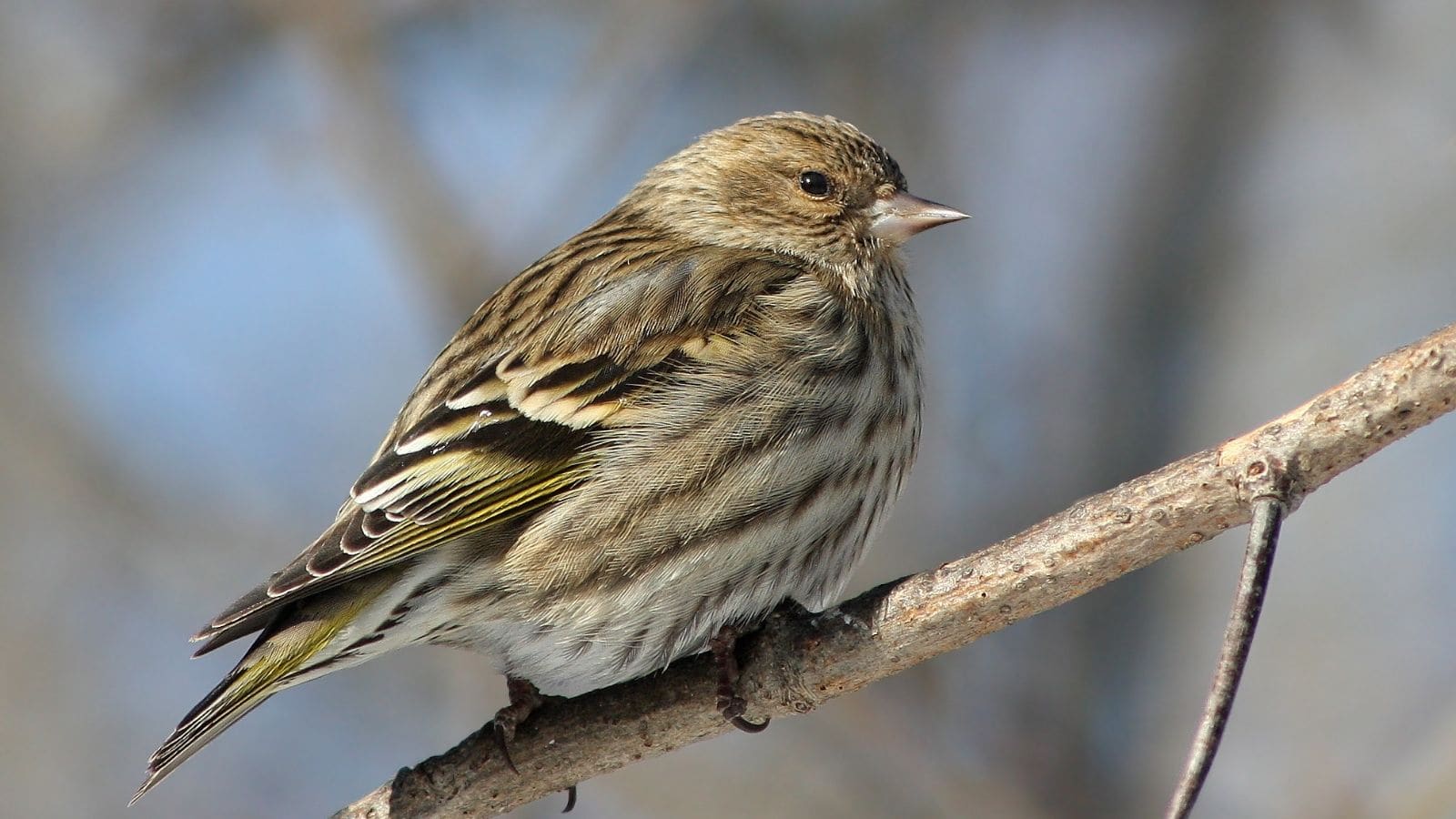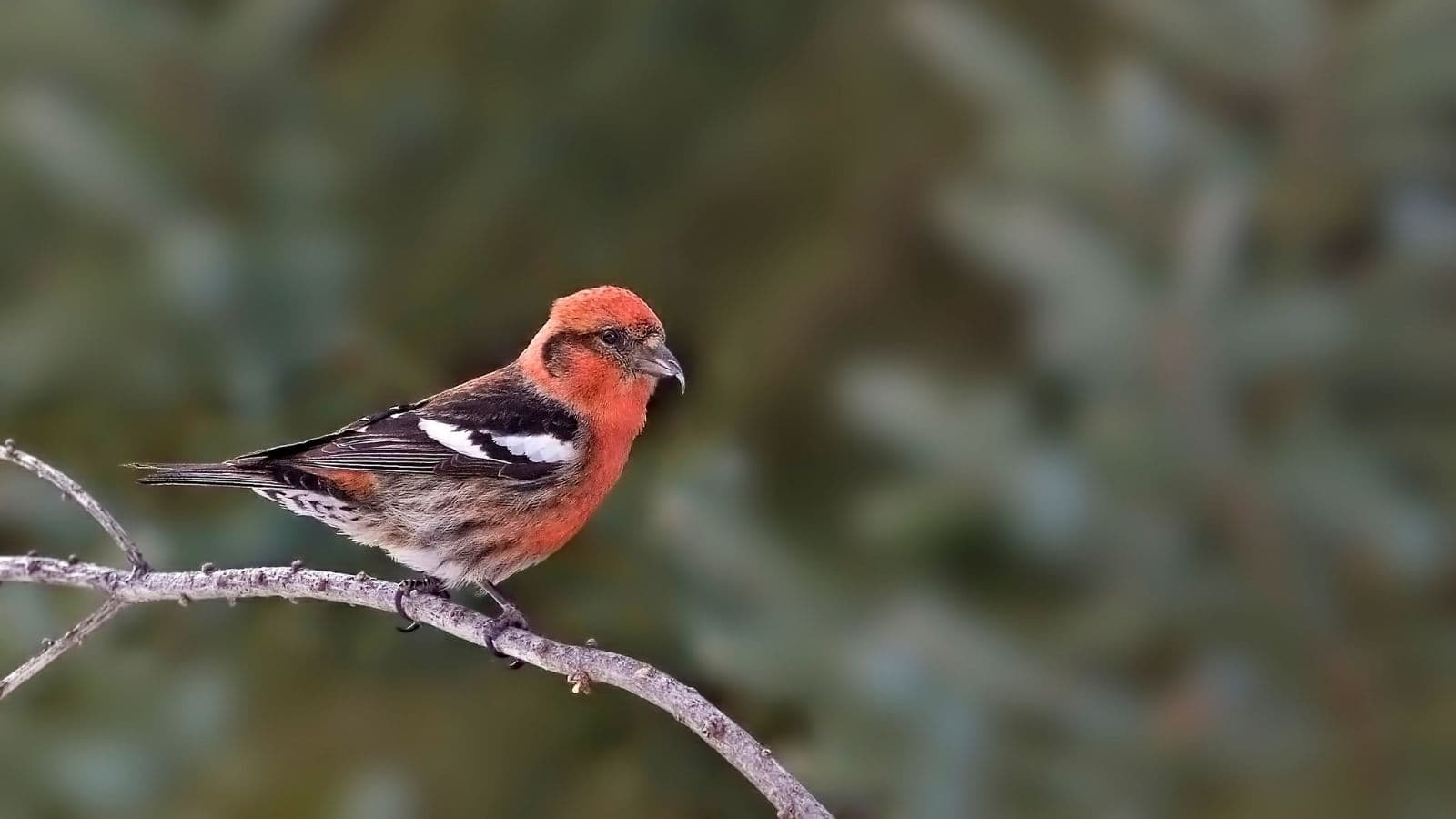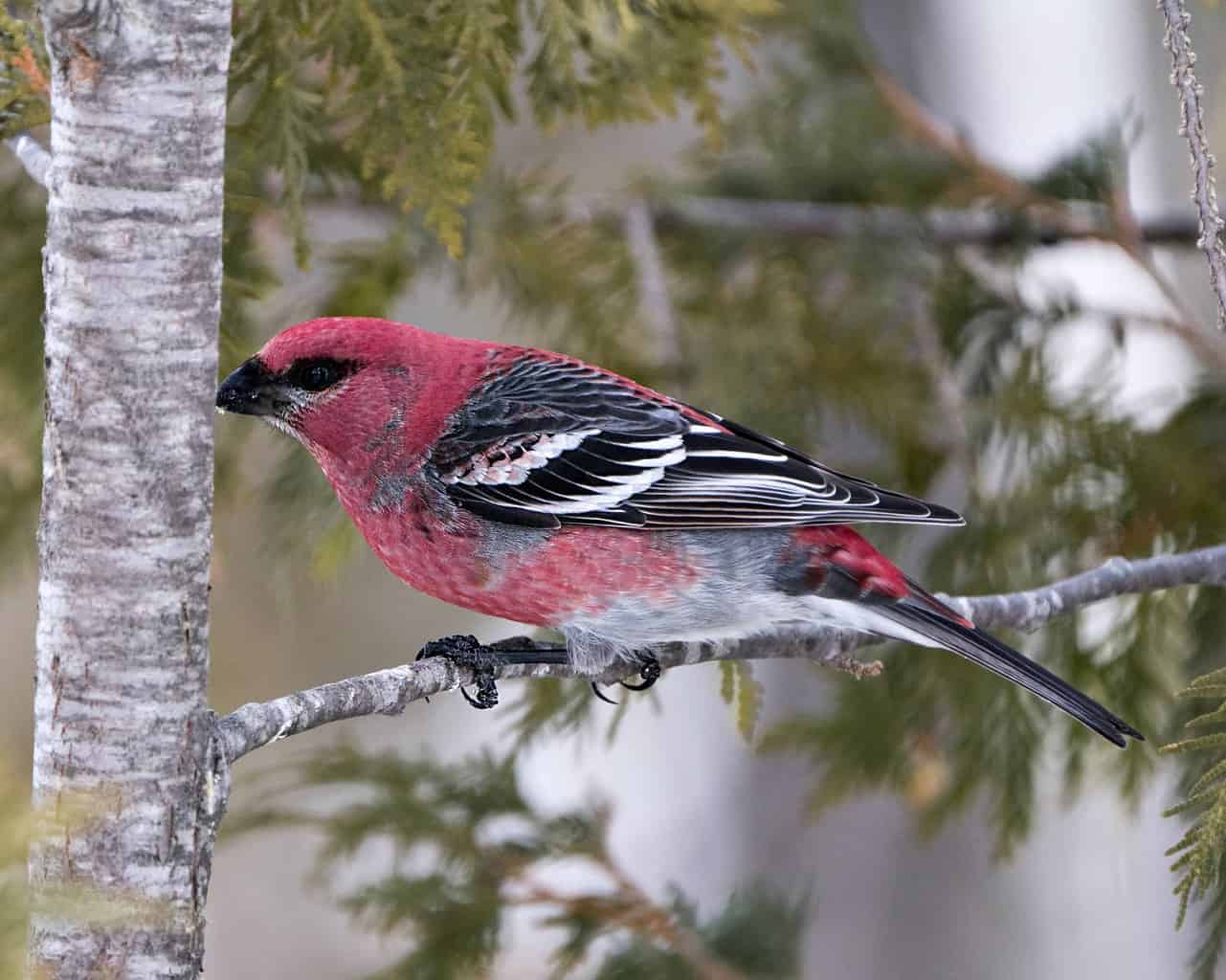With a mixture of tallgrass prairie and savanna in upland districts, and dense forests and wetlands on lowland flood plains, Iowa has a mixed landscape to suit a wide variety of birds.
Of the 430 bird species that can be seen in Iowa, there are four common finches and a handful of rarer ones.
Finches are a fascinating family of birds that range from everyday backyard birds like American goldfinches and house finches to exotic nomadic wanderers like crossbills and grosbeaks.
One of the best ways to get a closer look at these seed-eaters is to feed them with various types of seeds at bird feeders. Platform feeders and tube feeders are both great choices to draw them in.
But exactly which delightful finches can be seen in Iowa? I bet you can’t guess them all, but see how many you can get before scrolling down!
Finches in Iowa, Starting With the Most Common
American Goldfinch

- Scientific Name: Spinus tristis
- Length: 4.3-5.1 in (11-13 cm)
- Weight: 0.4-0.7 oz (11-20 g)
- Wingspan: 7.5-8.7 in (19-22 cm)
Not only is the American goldfinch one of the most dazzling finches, but it’s also one of the most common of all birds in the Midwest during summer months. Frequently seen here in winter, too, it’s hardly surprising that it’s been officially named the State Bird of Iowa.
As with many other finches, American goldfinches are much brighter and more colorful in spring and summer than in winter. During the breeding season, males don lemon-yellow feathers, combined with a shiny black forehead and wings.
Between October and February, nearly half of all Iowa’s American goldfinches migrate south to milder climates. At this time of year, males appear much like females with gray and very muted yellow plumage.
Goldfinches are among the most voracious visitors to backyard bird feeders, and this species is especially fond of sunflower seeds and thistle seeds. Special thistle feeders have been developed to draw in large numbers of these greedy birds!
House Finch

- Scientific Name: Haemorhous mexicanus
- Length: 5.1-5.5 in (13-14 cm)
- Weight: 0.6-0.9 oz (16-27 g)
- Wingspan: 7.9-9.8 in (20-25 cm)
House finches are now the second most common finch in the Midwest – an amazing fact given they were hardly seen here until the 1980s!
Bizarrely, house finches were originally only native to Mexico and the Westernmost United States, until caged birds were released into the East. They flourished so well here that they soon began to displace native eastern species.
Part of the house finches’ secret to success is their compatibility with human development. While other finches have suffered from habitat loss, house finches positively thrive on farms and cities, where they often nest in or around buildings.
Handsome birds, male house finches, have bright red breasts. While they can be confused with other finches by sight, their slower, husky song is a good way to distinguish them.
Purple Finch

- Scientific Name: Haemorhous purpureus
- Length: 4.7-6.3 in (12-16 cm)
- Weight: 0.6-1.1 oz (18-32 g)
- Wingspan: 8.7-10.2 in (22-26 cm)
The purple finch is the primary victim of the house finches’ rise to dominance in the Midwest. While they used to be more common here, they’re now only seen by around 4% of birdwatchers in winter, and by less than 0.5% during the breeding season.
This is a shame because purple finches are even more colorful birds than their invasive relatives. Male birds have bright red to pink (but not purple!) wash from their crown to their rump, while females are brown, streaky, and hard to differentiate from their cousins.
Unlike house finches, purple finches are not attracted to buildings, but will still visit backyard feeders. Sunflower seeds fed from platform feeders and tube feeders are a great way to coax them to your garden in the colder months.
Unlike the more sedentary house finch, most purple finches fly north when the spring rolls around. Most of them breed in Canada, although a few remain behind to breed in the Midwest, too.
Pine Siskin

- Scientific Name: Spinus Pinus
- Length: 4.3-5.5 in (11-14 cm)
- Weight: 0.4-0.6 oz (12-18 g)
- Wingspan: 7.1-8.7 in (18-22 cm)
Now for a truly nomadic finch. Pine siskins are found in every state of mainland USA and Canada, but rarely stay in the same place for long. In their eternal quest for abundant crops of pine, birch, alder, and thistle seeds, flocks of siskins travel far and wide to appease their voracious appetites.
Because their presence largely depends on each season’s crop, they’re known as an ‘irruptive species’. Abundant in some years, but almost absent in others, they’re seen by an average 4% of bird watchers in Iowa in winter, but occasionally breed here, too.
Siskins often join flocks with goldfinches, and the two species can be easily confused during the colder months. Siskins have a more streaked appearance than their relatives, however, and can also be identified by their metallic, rasping calls.
When they’re in the locality, pine siskins will gladly fuel up at bird feeders. Sunflower seeds and nyjer seeds make for welcome winter fodder!
Common Redpoll

- Scientific Name: Acanthis flammea
- Length: 4.7-5.5 in (12-14 cm)
- Weight: 0.4-0.7 oz (11-20 g)
- Wingspan: 7.5-8.7 in (19-22 cm)
Another wandering finch is the common redpoll. But unlike the purely continental pine siskin, the common redpoll takes its nomadic adventures to an international level!
Amazingly, common redpolls can be found at Northerly latitudes around the entire Northern Hemisphere. From Alaska to Siberia, to Iceland, and back again to New England, common redpolls have spanned the globe in their search for rich feeding grounds.
Redpolls only show up in Iowa during the winter, and since the northern half of the state represents the southern tip of their winter grounds, they can be considered a fairly rare bird here.
Both male and female redpolls have red crowns, but only males display a pinkish chest. Listen out for their noisy, repetitive chirps and trills as they travel around in flocks, searching busily for birch and weed seeds.
Red Crossbill

- Scientific Name: Loxia curvirostra
- Length: 5.5-6.5 in (14-17 cm)
- Weight: 1.4 oz (40 g)
- Wingspan: 10-10.75 in (25-27 cm)
Red crossbills are among the most exotic and fascinating finches in North America. With their bright colors and tame, playful nature, they’re a real treat for any bird watcher to stumble across.
Seeing crossbills is always a lottery because you never know where and when they’ll pop up. These nomadic birds move over huge distances in search of the conifer seeds that they depend on as their favorite food.
It’s not even possible to know where crossbills might nest since they simply build wherever and wherever food is abundant – even in the middle of winter!
As coniferous forest specialists, red crossbills are usually only seen in Iowa when crops fail further north, so seeing them here is all the more special.
White-Winged Crossbill

- Scientific Name: Loxia leucoptera
- Length: 5.9-6.7 in (15-17 cm)
- Weight: 0.8-0.9 oz (24-26 g)
- Wingspan: 10.2-11.0 in (26-28 cm)
A close cousin of the red crossbill, white-winged crossbills look very much like their relatives except for the white patches on their wings and a slightly more slender appearance. Females are also a dull yellow compared to the brighter green of their female cousins.
Like the reds, white-winged crossbills have evolved a peculiar bill that really is crossed at the tips. This specialized tool is used to pry open unopened conifer cones so they can reach the seeds before other birds and mammals have the chance.
White-winged crossbills also nest at any time of year, with nests made from twigs, grass, moss, and lichens. They lay up to five eggs and feed the young on – you guessed it – conifer seeds!
Just like the red crossbill, these birds are a northerly species that are rarely seen in Iowa, although they can be seen year-round in neighboring Minnesota and Wisconsin.
Evening Grosbeak

- Scientific Name: Hesperiphona vespertina
- Length: 6.3 to 8.7 in (16 to 22 cm)
- Weight: 1.37 to 3.04 oz (38.7 to 86.1 g)
- Wingspan: 12 to 14 in (30 to 36 cm)
With bright gold around their crown, black and white wings, and perhaps the most formidable bill of all finches, the Evening grosbeak is a truly majestic finch that is always thrilling to encounter.
In Iowa, spotting an evening grosbeak is all the more exciting for how rarely they’re seen here. They only show up on less than one in a thousand bird watcher’s reports here, so can be considered accidental in all but the most northeasterly corner of the state.
Incredibly hardy birds, evening grosbeaks are seen more frequently in Canada and the Rocky Mountains than in the Midwest, but will occasionally travel further south when food is scarce in their usual range.
Their enormous bill allows them to crack open seeds that other birds can’t manage, meaning there’s usually some leftover food for them to clean up after other finch flocks have already passed through.
Pine Grosbeak

- Scientific Name: Pinicola enucleator
- Length: 7.9-9.8 in (20-25 cm)
- Weight: 2.01 oz (57 g)
- Wingspan: 14.5in (33 cm)
Pine grosbeaks are the largest of all finch species in the world and are spectacular birds to behold. Both sexes have long, notched tails, stubby bills, and white wing bars, but whereas the males are reddish in color, the females are gray-brown.
In summer, pine grosbeaks nest in the far north or at high altitudes in spruce and fir forests. In winter, they sometimes travel south, especially when regular food sources are in short supply.
To see them as far south as Iowa, however, is exceptional. There can sometimes be 10 years go by between sightings here, although when they do appear, they’ll often do so in substantial numbers.
Pine grosbeaks usually travel in small flocks and because they’re fond of eating fruit, tree buds, and insects, they’re often attracted to orchards. They’re especially fond of crab apples and mountain ash berries.
Hoary Redpoll

- Scientific Name: Acanthis hornemanni
- Length: 4.7-5.5 in (12-14 cm)
- Weight: 0.4-0.7 oz (11-20 g)
- Wingspan: 8.5-9.25 in (22-23 cm)
Even more of a northern specialist than the common redpoll is the hoary redpoll (aka. Arctic redpoll). Miraculously, they’re one of the few bird species to survive in the Arctic tundra year-round, although many do opt to head south for winter!
Hoary redpolls are not seen as far south as Iowa very often, though, so seeing them here should be considered a privilege. They’re also very difficult to distinguish from common redpolls, and will often mix with them in flocks.
While it takes a good pair of binoculars to distinguish the species, hoary redpolls average paler and fluffier, and have smaller bills than common redpolls. The two species even have almost identical songs and calls as one another.
Like other birds in the Arctic, hoary redpolls may be vulnerable to climate change. As the seasonal cycles and food sources that they depend on start to shift, their populations could become threatened.
A Few That Got Away!
There are a few types of finches that are spotted in Iowa even less often than the rarest species above.
The lesser goldfinch, gray-crowned rosy-finch, and brambling have all been recorded in Iowa, but it can often be several years between sightings.
If you do spot any of these species of finch, be sure to report it to a local birdwatching authority, such as the Iowa Ornithologists Union.
Conclusion
Whether you’re watching purple finches clean up thistle seeds at your backyard feeder or catching a rare glimpse of a crossbill picking open pine cones overhead, there are endless opportunities to get acquainted with the fascinating finch family.
Because some finches look so similar to sparrows, it can be a great idea to get to know the sparrows in the locality, too. We’ve compiled a comprehensive list of Iowa’s sparrows here, and you might be surprised at how many there are!

